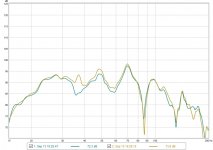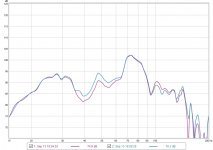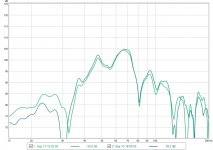For setting up speakers, it means you could put your sub where you sit and search around the room with a mic to find a location that gives best results.
Good post!
Come to think we could as well just use our ears (especially when in lack of any aiding instruments) to locate a good spot where the LF audio response sounds subjectively good by moving ourselves around to different positions in the listening room in order to find out a location where we could place our sub.
I assume several relatively smaller subs substituting one big sub would be a better choice in order to get a more even LF response.
Yes, sub hanging in air is one very good question. But also matter of point source and point receiver, is damping around the room linear, polar/directionality issues of speaker, mic, and ears (and in relation to room furnishings), etc.Whether or not you are generating the same waves with differential loading is the pertinent question.
My basic problem is that it is plain lousy methodology to do anything except measure from the point of reference (your head); not wise to work otherwise, unless that was unfeasible and/or the degree of error is tolerable.
But I sure hope somebody can provide pictures and traces of the method working in a normal home music room, as compared to regular method.
Ben
One of the assumptions made by the reciprocity theorem is that the source and receiver are both very much smaller than the wavelengths at play, and also the room itself. The two must also have the same directional characteristics.
For instance, imagine a subwoofer that takes up 1/4 of the room. Moving it around would alter the shape of the room in a significant way, while moving the microphone around would not.
So, I'd argue it's a good first-order approximation, but second-order effects may come in when the basic assumptions are challenged.
Chris
For instance, imagine a subwoofer that takes up 1/4 of the room. Moving it around would alter the shape of the room in a significant way, while moving the microphone around would not.
So, I'd argue it's a good first-order approximation, but second-order effects may come in when the basic assumptions are challenged.
Chris
That's interesting, thank you. Is there any way in your simulation you can add random shapes to simulate pieces of furniture preferably placed at angles and maybe even different amounts of absorption and reflection?Let's try.
View attachment 633997
View attachment 633998
Being a DIYers or engineers we couldn't believe strong math, especially if it provides repetitive results corresponding with real measurements. (Or even this math is created to correspond with experimental).
But the most valueable ability is to show results in intuitive and clearly understandable way.
One of the assumptions made by the reciprocity theorem is that the source and receiver are both very much smaller than the wavelengths at play, and also the room itself. The two must also have the same directional characteristics.
Chris
This is a good point. Another end member is also an issue, when wavelengths are much longer than the spatial scale of the scatterers. In fact, an 'infinite frequency' approximation is commonly used, effectively collapsing the wave to treat it as a 1D ray. Scattering of very long wavelengths is usually treated with expensive numerical techniques.
Many good points here. And particularly applicable to modest-sized home music rooms.This is a good point... Scattering of very long wavelengths is usually treated with expensive numerical techniques.
scotjoplin -
Are you missing the point? The sim is simply a mathematical cousin to the Reciprocity Theorem and can't be "tested" except empirically. These sims will always reciprocate perfectly. As the previous posts show, it is fair to raise questions about the assumptions. But the sim does not raise questions about its own assumptions!
i believe BesPav thoughtfully and subtly raised these questions by his ironic way of writing.
Again, it it possible that the degree of error using lousy methods can still be OK for most purposes. While I am a strong advocate of test-and-relocate your sub(s) around the room, the acoustics of a home room are pretty loose. My room changes a lot when I leave a clothes-closet door open.
http://www.diyaudio.com/forums/subwoofers/280236-simulation-sub-corner-placement.html#post4465835
Post #16. Look closely at traces below 75 Hz. Quite different. Sure is better with the door slid open and all my winter motorcycle clothing soaking up some of a mode or two in the perfect location. This also illustrates why good methodology leads to stable results.
B.
Last edited:
i believe BesPav thoughtfully and subtly raised these questions by his ironic way of writing.
:beer:
Yeah, you hit the bull's-eye!
Why strain and provide all your brute force while you can subtly sneer and chuckle?
The less vociferous statements the easier it is to plant a grain of doubt.
I had a little time to burn tonight, so I decided to try this reciprocity theory out. I don't have a lot of time to post a detailed write up at this time, but I will do my best. The equipment used was REW with a calibrated mic and a 10" powered bass reflex subwoofer. I tried 4 different locations around the room and the 5th or common location being one of my theater seats. When placing the mic or subwoofer in the locations around the room I made sure the mic was exactly where the cone of the subwoofer was and vise versa. If it helps, my room is 15' wide x 24' deep. The front of the room is 15' wide.
The first image is with the subwoofer or mic in the front left corner of the room and the mic or subwoofer on one of the theater seats.
The second image is centered on the front wall on the floor.
The third image is in the same spot but raised off of the floor 3'.
The fourth image is centered on the right side wall.
Hope this was helpful.
Regards,
Matt
The first image is with the subwoofer or mic in the front left corner of the room and the mic or subwoofer on one of the theater seats.
The second image is centered on the front wall on the floor.
The third image is in the same spot but raised off of the floor 3'.
The fourth image is centered on the right side wall.
Hope this was helpful.
Regards,
Matt
Attachments
That's immensely helpful. Wonderful. Clearly Helmholtz spoke the truth in proposing reciprocity theorem (not that anybody doubted its theoretical truth).
My impressions (and responses to Matt's traces are inevitably different among people and purposes):
1. big differences among those four locations and clearly you'd want to test various locations before deciding where to locate your sub; if choosing a location was your primary goal, the reciprocity method is pretty good for a big-picture of your bass sound, as long as you work as carefully as Matt. Maybe not a perfect as the sims predict, but pretty good.
2. the first graph, in the corner, looks like the best prospect to me; but looking at one of the traces (not sure which test it represents) you might say, "umm, this needs some help at 37 Hz and 48 Hz" but you could be preferring another location (in error) if you were working with Matt's reciprocal test; of course in your home, you wouldn't know which is which unless you tested the old way after positioning your sub and then applied the EQ.
So, looking at Matt's data, the reciprocal method is helpful as a gross test but it might be wrong in the fine points and in another room very wrong. Some rooms might show better agreement than Matt's but some may show worse and lead you to a sub-optimum sub location.
If it were simple enough to move your sub, that sure is the way I would work rather than accept an unknown degree of uncertainty. If not, looks like the reciprocal approach can be very helpful.
The degree of smoothing Matt used seems about right to me. But it would be instructive to look at the same traces with one increment less smoothing, when Matt has the time.
B.
My impressions (and responses to Matt's traces are inevitably different among people and purposes):
1. big differences among those four locations and clearly you'd want to test various locations before deciding where to locate your sub; if choosing a location was your primary goal, the reciprocity method is pretty good for a big-picture of your bass sound, as long as you work as carefully as Matt. Maybe not a perfect as the sims predict, but pretty good.
2. the first graph, in the corner, looks like the best prospect to me; but looking at one of the traces (not sure which test it represents) you might say, "umm, this needs some help at 37 Hz and 48 Hz" but you could be preferring another location (in error) if you were working with Matt's reciprocal test; of course in your home, you wouldn't know which is which unless you tested the old way after positioning your sub and then applied the EQ.
So, looking at Matt's data, the reciprocal method is helpful as a gross test but it might be wrong in the fine points and in another room very wrong. Some rooms might show better agreement than Matt's but some may show worse and lead you to a sub-optimum sub location.
If it were simple enough to move your sub, that sure is the way I would work rather than accept an unknown degree of uncertainty. If not, looks like the reciprocal approach can be very helpful.
The degree of smoothing Matt used seems about right to me. But it would be instructive to look at the same traces with one increment less smoothing, when Matt has the time.
B.
Last edited:
But it is possible to substitute a smaller sub that still has enough bass extension since that will be easier to place 4 feet off of the ground.
OK... that's the next question that needs investigation. Hard for me to picture learning about one speaker by testing another.
But is there value in reciprocal testing when you test with a speaker that is easier to put on your chair?
B.
OK... that's the next question that needs investigation. Hard for me to picture learning about one speaker by testing another.
But is there value in reciprocal testing when you test with a speaker that is easier to put on your chair?
B.
So long as the assumptions I mentioned earlier hold, I see no reason why not.
ie, you can't use a 5" PC subwoofer to simulate a giant tapped horn, since the TH will be changing the shape of the room as it moves.
That said, if the smaller sub still has the bandwidth of the bigger sub, it should work just fine.
Chris
Respectfully, your first point negates the theory of reciprocity (although prolly somewhat true!).since the TH will be changing the shape of the room as it moves.
That said, if the smaller sub still has the bandwidth of the bigger sub, it should work just fine.
On your second point, all subs differ from one another in FR in dramatic ways in a room. The object of moving subs around it to mix-and-match the sub FR to the room modes (and when lucky, they will complement one another very nicely, as Matt's first panel shows).
So, can you take any sub and think it can be stand-in for another sub? It is possible that the reciprocal method nicely addresses major room mode influences and, therefore, you can. I am not sure if Matt's data address this question... perhaps a closer look at his box resonance(s) will clarify it. Dunno.
B.
Respectfully, your first point negates the theory of reciprocity (although prolly somewhat true!).
B.
No, it doesn't.
One of the assumptions made by the theory of reciprocity is that both the source and receiver are very much smaller than the room and the wavelengths under consideration. When that's no longer true, the theory needs to be modified for those second-order effects.
Chris
I was reading about 6th order and ROAR boxes with oodles of sims and almost no actual performance measurements. So I was wondering if the reciprocal method might be helpful in getting systems out of the drydock and into the water?
The problem is that sims provide posits for how a system will perform in ideal locations. In practice (and for those lacking anechoic chambers with low frequency capacity), that means figuring out how to test you sub in a large empty space out of doors and even hanging in the air. (There are some inspiring pictures on the web of just such testing using large cranes to hoist the speaker in the air.) Sure, it can be done but quite a feat even just at ground level and away from civilization.
Could you make measurements with a bunch of different small speakers placed in the location to later filled by the device to be tested. That would provide an image of the room influence. Then, when the device is put in place you could assess the difference.*
Just wondering.
B.
*of course, you aren't doing anything reciprocal here but the thought was inspired by Matt's evidence showing that the "ghost" of the room - for THAT speaker location and your specific chair location - is superimposed on the whatever speaker is placed in the test location; by averaging a few different subs, you are getting a better image of the room impact... and if you have doubts about this proposal, then you have doubts about the Reciprocity Method
The problem is that sims provide posits for how a system will perform in ideal locations. In practice (and for those lacking anechoic chambers with low frequency capacity), that means figuring out how to test you sub in a large empty space out of doors and even hanging in the air. (There are some inspiring pictures on the web of just such testing using large cranes to hoist the speaker in the air.) Sure, it can be done but quite a feat even just at ground level and away from civilization.
Could you make measurements with a bunch of different small speakers placed in the location to later filled by the device to be tested. That would provide an image of the room influence. Then, when the device is put in place you could assess the difference.*
Just wondering.
B.
*of course, you aren't doing anything reciprocal here but the thought was inspired by Matt's evidence showing that the "ghost" of the room - for THAT speaker location and your specific chair location - is superimposed on the whatever speaker is placed in the test location; by averaging a few different subs, you are getting a better image of the room impact... and if you have doubts about this proposal, then you have doubts about the Reciprocity Method
Last edited:
I was reading about 6th order and ROAR boxes with oodles of sims and almost no actual performance measurements. So I was wondering if the reciprocal method might be helpful in getting systems out of the drydock and into the water?
The problem is that sims provide posits for how a system will perform in ideal locations. In practice (and for those lacking anechoic chambers with low frequency capacity), that means figuring out how to test you sub in a large empty space out of doors and even hanging in the air. (There are some inspiring pictures on the web of just such testing using large cranes to hoist the speaker in the air.) Sure, it can be done but quite a feat even just at ground level and away from civilization.
Could you make measurements with a bunch of different small speakers placed in the location to later filled by the device to be tested. That would provide an image of the room influence. Then, when the device is put in place you could assess the difference.*
Just wondering.
B.
*of course, you aren't doing anything reciprocal here but the thought was inspired by Matt's evidence showing that the "ghost" of the room - for THAT speaker location and your specific chair location - is superimposed on the whatever speaker is placed in the test location; by averaging a few different subs, you are getting a better image of the room impact... and if you have doubts about this proposal, then you have doubts about the Reciprocity Method
There's no need to hang speakers in the air, you can test them on the ground. The ground is a large uniform boundary, close enough to infinite in size that it will provide a near perfect reflection.
What you seem to be asking is if you can measure the room gain curve. Of course you can. Here's an article on it.
Data-Bass
- Status
- This old topic is closed. If you want to reopen this topic, contact a moderator using the "Report Post" button.
- Home
- Loudspeakers
- Subwoofers
- Reciprocity Theorem in practice



